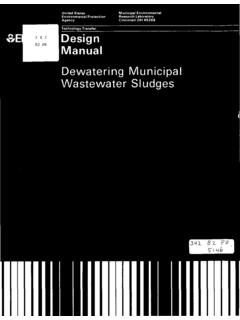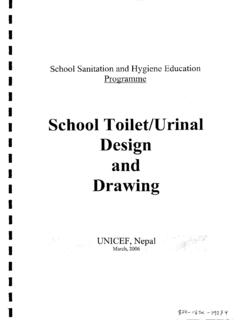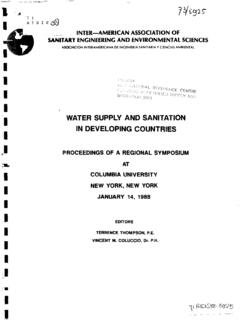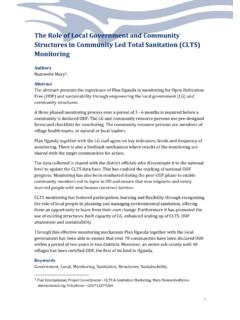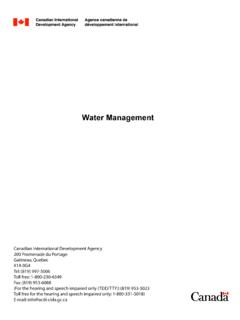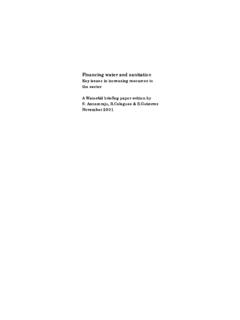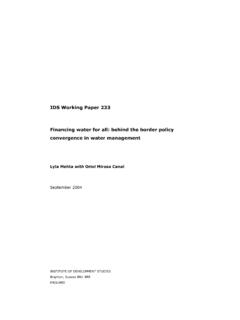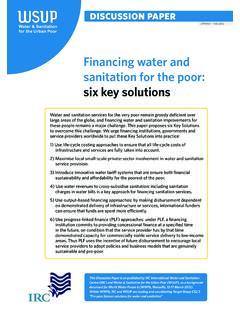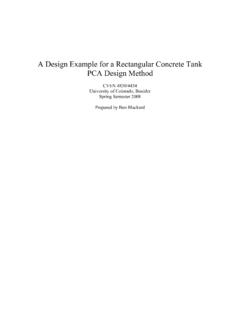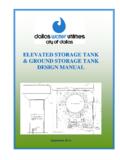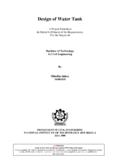Transcription of 217 81 IR SWD STEERING COMMITTEE WIND ENERGY …
1 217 81 IR SWD STEERING COMMITTEE wind ENERGY developing countries Irrigation Water Storage Tanks made of Brickwork A manual for design and construction December 1981 IDH\f TWO DHV Consulting Engineers Technical Working Group for developing countries 2Q- \ Ifc-ty 2 CONTENTS PAGE 1. PREFACE 4 2. IRRIGATION WATER STORAGE TANKS MADE OF MASONRY Introduction Construction manual Site clearance and preparation of foundations Construction materials Bricks Cement Sand Water Mortar mix Construction Instructions for bricklaying Plaster Tools Plastic foil or lining Bund earth wall Work instructions, drawings watertank Type 1 watertank type II watertank type III watertank type IV watertank type V Typical details Testing Introduction Testing construction materials Choise of bricks Simple field identification tests Testing masonry construction Testing of a brick wall General starting points for the structural calculations Calculation of the tanks Tank capacity of 30 m3 Tank capacity of 60 m3 Tank capacity of 90 m3 Tank capacity of 150 m3 Type III, IV, V 5 5 5 5 6 6 6 6 6 6 7 7 8 8 8 8 9 10 17 25 33 41 49 54 54 54 54 55 57 57 61 63 63 64 65 67 69.
2 3 CONTENTS (continued) PAGE Annex 1 reinforcement in the tankwall 72 Annex 2 review of the several types # 73 Annex 3 design table 74 Annex 4 list of symbols 75 Annex 5 bibliography 76 /-- 4 1. PREFACE The SWD ( STEERING COMMITTEE on wind - ENERGY for developing countries ) has designed and built windmills for irrigation purposes in developing coun tries. To achieve properly regulated irrigation, water storage is a necessity. Up to now, water storage tanks have been built using general construction materials. Experience shows that the cost of water storage tanks can equal the cost of a windmill. Also some storage tanks were liable to damage during use and because of lack of know-how.
3 Discussions with TWO resulted in a contract between SWD and DHV. Under this contract DHV prepared designs and construction manuals as described in this publication. As a first step, designs and construction manuals have been prepared for masonry tanks with storage capacities of 30 m3 - 60 m3 - 90 m3 and 150 m3. These are described in this booklet. Designs for tanks made of bund walls, ferro cement, plastic foil tubes with stabilized soil and a combination of ferro cement and masonry will be prepared in a later stage. The authors are grateful for the support, and critisism, that they received from the SWD. The authors: J. Costa J. de Lange C. Pieck 2. IRRIGATION WATER STORAGE TANKS MADE OF BRICKWORK Introduction Descriptions and drawings have been made showing masonry tanks with a capacity of 30-60-90 and 150 m3 with five several types. As shown, several constructions are possible. A summery of the several types of tanks reads as follows: Page Type 1: a fully brickwork tank, walls and slabs, without a bund earth wall Type II: same as type I but with a bund earth wall Type III: brickwork ringfoundation with a bund earth wall.
4 The remaining bottomslab of the tank will be made of clay (impermeable soil) Type IV: as type III but with a different foundation of the brickwork ring Type V: as type III or IV but with tie rods made of steelstrips and without a bund earth wall In the description of each type of tank a short building instruction is given with some characteristic properties. In the notes, added to the description, some differences between the tanks are shown. Furthermore, on page 73 a review is presented which helps in choosing the type of tank to be constructed. The drawings show details with dimensions for each tank and are completed with a bill of quantities. The content, text and illustrations of the manual are primarily keyed to a semi-professional reader, although professional engineers may also find the manual useful. One chapter describes methods of testing total masonry walls and of the building materials. For reasons of safety it may be necessary to test the "sample wall" as well as the materials before starting construction of a tank.
5 In the last chapter consideration is given to the theory of the structural calculations for the tanks. Construction manual Site clearance and preparation of foundations The site chosen for the tank should be cleared. At least the topsoil with a layer of approx. 200 mm is to be excavated to be sure that all vegetation, loose surface soil and black soil are removed. If necessary the surface should be (roughly) levelled. After clearance it is advisable to backfill a sand and/or gravel layer of approx. 200 mm thick. The ensuing compaction is done by means of ramming with (self-made) tampers. When for backfill sand is used compaction can also be done by sprinkling with a little water and ramming. Construction materials Bricks The bricks must be of good quality in order to obtain a watertight structure. Prior to laying, the bricks must be moistened with water. To prevent cracking caused by shrinkage and high temperatures the tank should be moistened during the first three weeks or protected by means of a cover (plastic foil).
6 Cement The cement to be used in the mortar should be an ordinary Portland Cement (in accordance with BS 12 or similar specification).In the case of-aggressive soil due to a high salinity, Portland Cement 5 or blast furnace cement must be used. Lower strength cements are not recommendable. The cement must be stored in a dry place. Sand The first requirement for sand is that it should be free from organic and chemical impurities which may weaken the mortar. A coarse silica sand is probably the best for the purpose. The use of coarse sand will lessen the workability of the mortar but its resistance to shrinkage will be greater than that of a mortar made with fine sand. Water The water must be clean and free from acid chemicals, salt and organic matters. Salt water should never be used. Mortar mix Mortars for brickwork are a mixture of cement, sand and water, each ingredient having the correct proportion. For a maximum brickwork resistance to water pressure the following cement mortar mixes are advisable: a.
7 1 volume part of portland cement 2 volume parts of sand (fine aggregate) b. 1 volume part of portland cement 2,5 volume parts of sand (fine aggregate) c. 1 volume part of strong hydraulic powder-lime 0,25 volume part of portland cement 2,5 volume parts sand (fine aggregate) 7 If bricks of a somewhat lower quality are used, the quality of the mortar should also be lower (for instance 1 : 4^) in order to prevent shrinkage differences between the brick work and mortar. However, it should not be forgotten that any such reduction in quality may result in a less rigid construction and will certainly result in a less watertight structure. The mortar must be thoroughly mixed workable although one should remember that a dry mortar is stronger than a wet one. In any event the weight ratio of water to cement must not exceed 0,5 : 1. The portland cement should be fresh, old and/or wet bags with portland cement are to be removed. Water should be clean and free from harmfull matter, (see chapter "Testing") Where tests can be carried out they should be in accordance with the codes locally applicable.
8 The aggregate (sand) should be free from vegetable soil and black soil. Constructions When the site for the tank is cleared, its surface is levelled with a 200 mm thick layer of sand and/or gravel. The setting out can be done by driving a post into the ground at the centre point of the tank site and scribing a circle, while marking the ground at approx. 1 meter core to core with pegs. Instructions for bricklaying Clean foundation where bricks are to be laid Mark line of brickwork every 1 meter or so with pegs Mix the mortar (1 part cement, 2 tot 2\ parts sand) Add water to the dry mortar until the mortar can be handled well (beware of too much water) Moisten the bricks before laying so that the bricks do not trans-port water from the joints since such process causes joint cracks due to shrinkage. Bricks are not to b e moved or repositioned once the hardening process has begun. Spread "a good and ample mortar bed" for the first layer, making certain that the correctly placed masons line is worked to.
9 Do not place the mortar too far "in advance" of the proceeding bricks as the hardening process will start before the bricks are laid in their final positions. All heading joints (vertical) must be completely filled. Trowel off all excess mortar from the joints and re-use it. No "dead" mortar retrieved from the ground or other surface must be re-used. While laying bricks it is important to pay attention to the following rules for bonding: No vertical joints should be placed above each other. No closers must be used which are smaller than half the standard brick size locally available. 8 Plaster To ensure a more watertight construction it is advisable to scrape out the innerwall and slab joints and to apply an approximately 15 mm thick, rendering to the inner surfaces of the tank. 1 Part of cement to 5 parts of sand by volume batching. Tools The tools required are picks and shovels for levelling, spades, hammers (and nails), bricklayer's tools and accessories like trowel, pegs, cord wooden posts, mortar tub, plumb line, measuring tape, wheelbarrow and buckets.
10 Plastic foil or lining The floor of the tank can be formed of a layer of polyethylene sheeting, approximately 1 mm thick laid between two layers of sand (see type V). To ensure a more waterthight construction it is advisable to place an overlap of polyethylene sheeting in the horizontal brickwork jointing, both the sheeting and overlap then being joined by means of a flat or soldering iron. Bund earth wall To protect the tank construction against climatic influences it is advisable to form a bund around the tank circumference. A second advantage is that the bund will reduce the tensile forces and bending moments in the tankwall. When in type V a bund earth wall will be used the tierods made of steelstrips will not be a necessity. This bund is formed by heaping the excavated earth against the outside of the tank. When bad soil conditions are found (vegetation, black soil, loose surface soil) also the bund earth wall should have a proper foun-dation. In respect of this point the site clearance and preparation of the foundations are to be extended till the outer circumference of the bund earth wall and to be carried out as mentioned in , and After piling up the excavated earth against the outside of the tank the bund is finished by compaction.
